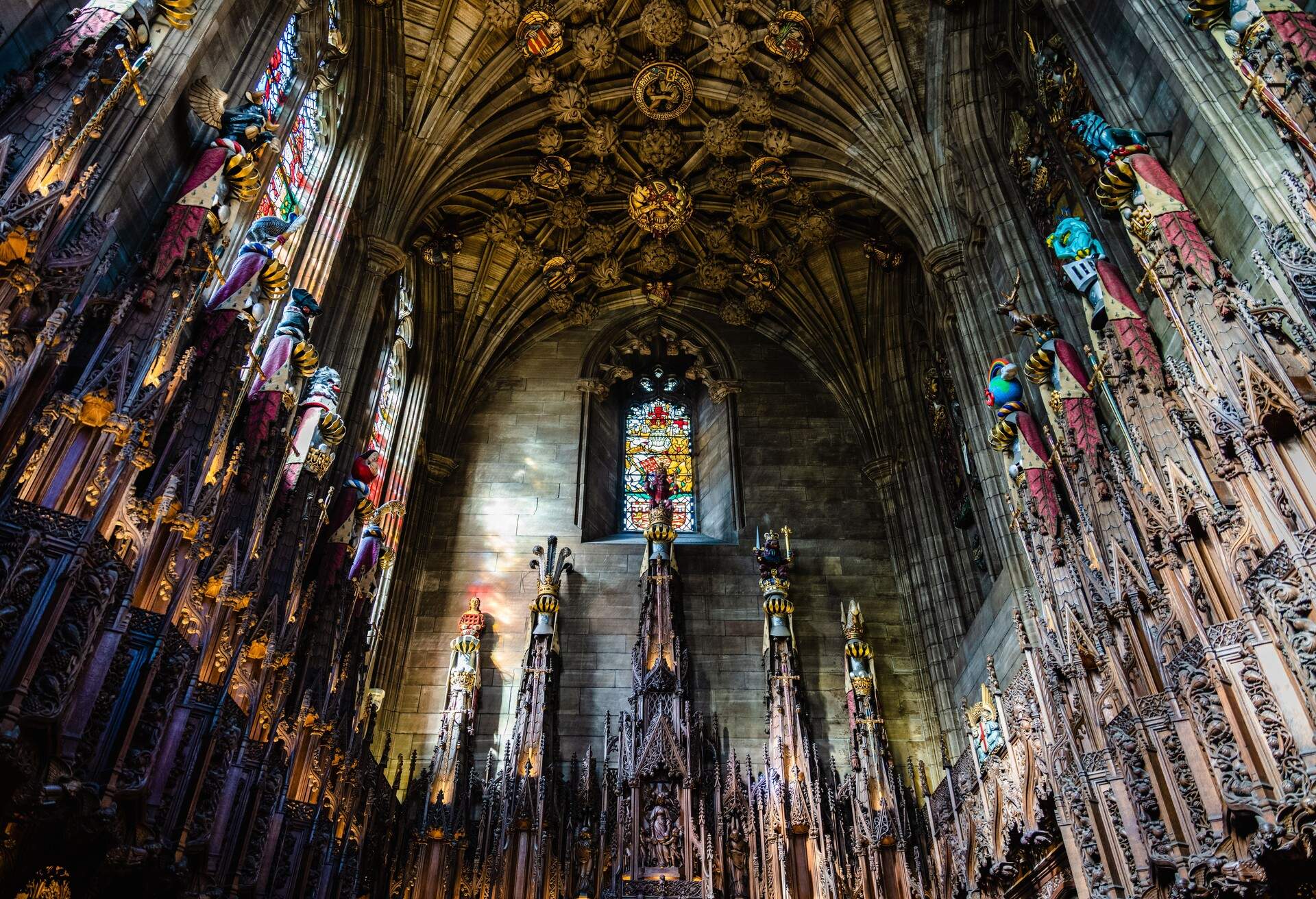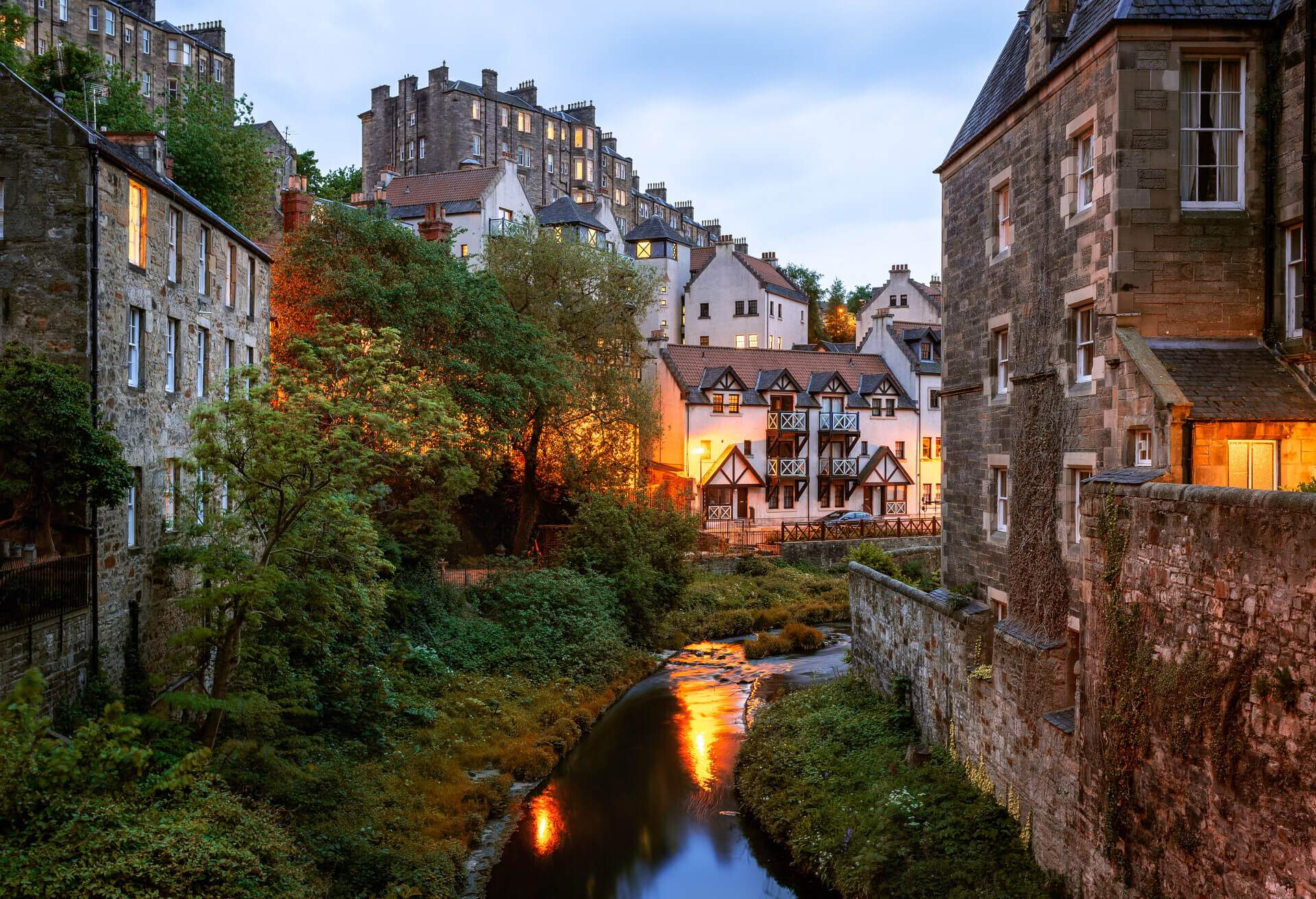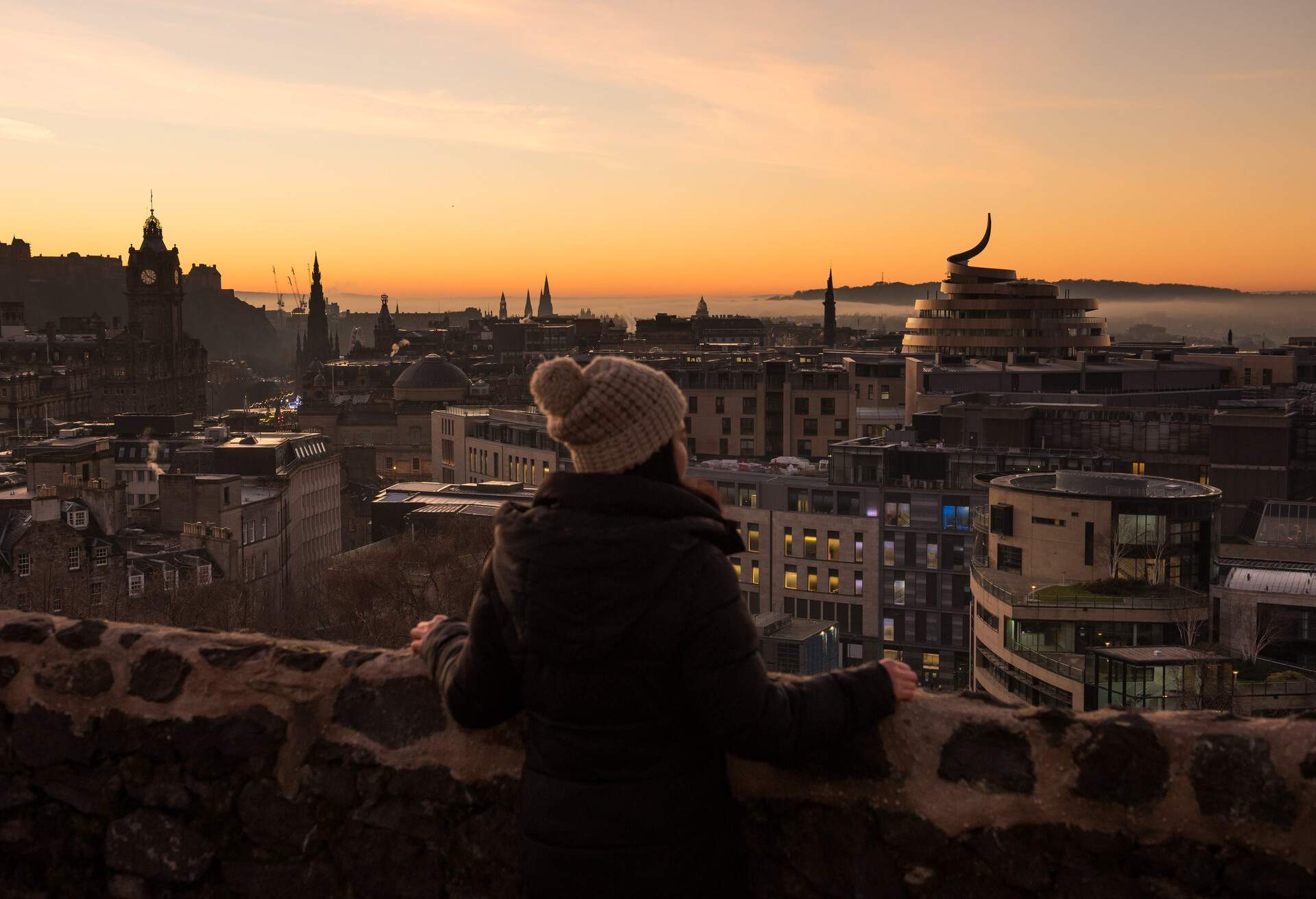The skylines of cities around the world are defined by the architecture found within them. Buildings are a fascinating record of the passage of time and often document a town’s development. The architecture in Edinburgh is a fine example of a city’s records through its buildings, from ancient days to modern-day times.
Architecture in Edinburgh

Edinburgh’s position, slightly elevated, gives it the perfect backdrop from which to admire some of the best, if not the most, ancient architecture in the world. Traversing various eras but mainly dominated by medieval times, the architecture in Edinburgh is a fine example of the growth of a city.
Old Town Edinburgh

In the Old Town part of the city, the Royal Mile is where many of the architectural gems lie. Running from the castle to the Royal Palace, you can see how the city sprawled out, with older buildings along the mile and newer ones off it. You will, therefore, find that the dominating style of building here is from the medieval era. Let’s delve into some of the highlights along the route.
Edinburgh Castle

Perhaps one of the most famous buildings in Edinburgh, one which can be viewed from anywhere in the city, is Edinburgh Castle. Sitting proudly on Castle Rock, a rock that has been inhabited by humans since the Iron Age, it’s the perfect example of medieval architecture found in the Old Town area and dates back to 1103. The location chosen for the castle was for a strategic reason; it was very hard to scale the wall in an attack. The walls surrounding it have turrets with spaces through which arrows would have been shot.
Having been built over several years, it evolved from a royal residence, a military garrison, a fortress to a prison and remains one of the oldest fortified places in Europe. Stepping into this building is like walking through a history lesson that spans so many eras architecturally.
Palace of Holyrood House

Standing at the end of Edinburgh’s Royal Mile, a thoroughfare that is almost a mile long, linked to the castle is the Palace of Holyrood House. It’s the official residence of the King in Edinburgh and a fine example of Scotland’s classical architecture.
Open for visits every day, there’s an opportunity to witness baroque decoration first hand. From many of its state apartments, you can see the grandeur of the royal family dating back hundreds of years. The King’s Chamber is one of the grandest rooms in the palace. Within it is a standing clock made in the late 17th century by one of London’s finest clockmakers. And for one of the most impressive sights in the palace, look up to the ceiling to see one of the finest paintings by Jacob de Wet II, depicting Hercules admitted to Olympus, The Apotheosis of Hercules – absolutely magnificent.
St Giles Cathedral

Historically, cathedrals are what gave a city its status; therefore, when looking at Edinburgh’s architectural heritage, St Giles Cathedral is a must. It’s one of the finest examples of Gothic architecture in the city. It is also one of the standout buildings along the Royal Mile, with an iconic 15th-century crown spire standing almost halfway between both the castle and the palace. Four of the central pillars inside the cathedral are the only remaining beams from the original chapel after it was destroyed by a fire in 1385, part of its turbulent religious history.
But one of the most impressive places to visit whilst at the cathedral is Thistle Chapel. Added on in 1911 and home to the Knights of the Garter, the highest and oldest order of Chivalry in Scotland, the architecture and history found here is mind blowing. Running along one side of the intricate walls are 16 hand-crafted Gothic-style wooden chairs that belong to the members that make up the garter. Each is adorned with intricate carvings on the back depicting the owner’s coat of arms. Presiding over them is the grandest chair, the royal stall, located at the centre of the west wall. It bares the court of royal arms and is where the King would sit.
The Scottish Parliament Building

Amongst the ancient buildings throughout Old Town, on a street off the Royal Mile, is one that is as modern as they come: the Scottish Parliament Building. Completed in 2004 to house the new Scottish Parliament, it’s the finest piece of modern architecture in Edinburgh. Designed in the shape of a tree, the building has a series of interconnecting rooms in various shapes inspired by traditional elements of Scotland, all coming together to form one of the most iconic contemporary buildings in Edinburgh.
The building is open for tours daily and is one of the best free things to do in Edinburgh, especially on Tuesday, Wednesday and Thursday, when parliament isn’t sitting; you can even attend a debate in person in the debating chamber.
The Hub

Another fine example of a Neo-Gothic style building along the Royal Mile is The Hub, formerly the Highland Tolbooth Kirk. A collaboration between a Scottish and English architect, it was meant to be a church, hence its spires, but was used as a meeting hall by the National Assembly up until 1929.
The spires, which tower over most of the buildings in the city centre, are the highest point in the city, aside from the castle at the top of the hill. It may appear older than its true age, built between 1842 and 1845, because dark sandstone was used in its construction.
The building is now used as an events venue and hosts various arts events.
The Mercat Cross

Last, but by no means least, whilst walking along the Royal Mile you are bound to come across the Mercat Cross. All across Scotland, you will find these crosses in towns or cities; they mark the spot that, at one point, there would have stood a busy marketplace. In medieval times, marketplaces were the hub of a town. They were where the town’s people met to exchange news and buy or sell their goods.
Located at Parliament Square, it’s one of the most famous. The original would have been made of wood and located a bit further down on the Mile; it is now a place marked by cobblestones. The new one, carved into a hexagonal stone, has been standing in its current position since 1617 with various additions in later years, including the unicorn that adorns it, the national animal of Scotland. This is the place where important public announcements are made, including that of the ascension of a new king or queen, as that of King Charles III’s ascension.
Victoria Street

Victoria Street is an intriguing part on the edge of Old Town, with some of the best Scottish architecture. Anyone with a love for architecture will thoroughly enjoy a visit here. It’s very much a part of the Scotland travel guide, as it’s also one of the most photographed streets in the city. Designed by Thomas Hamilton, an architect heavily influenced by the architecture of ancient Greece, it was meant to improve access around the city between 1820 and 1834.
His brief was to build in the Old Flemish style. There are so many interesting buildings along this charming street. Amongst them, the India Buildings were later added in 1864 in the then-fashionable Scots Baronial style, whilst the brush shop is very Dickensian, with a wooden counter and bare floor, whose facade hasn’t changed since the 1870s. Stories go that the street was home to a notorious wizard publicly executed and whose house was meant to have been destroyed, but it’s thought parts of it are hidden in the Quaker Meeting House.
New Town Edinburgh

Whilst Old Town Edinburgh is all about medieval architecture, New Town Edinburgh is the epicentre of Georgian and Neoclassical architecture, championed by William Henry Playfair, a leading architect in the 19th century. He is responsible for much of the building work in New Town Edinburgh, which earned it the reputation of ‘Athens of the North’, making it one of the best places to visit in Scotland.
In keeping with the Enlightenment philosophy that governed most of the building work during this time, most of the buildings are designed around a symmetrical, geometric plan. Don’t be fooled by the name New Town, as this UNESCO Heritage site has buildings dating back almost 250 years.
Circus Lane

A fine example of this can be found on the very edge of New Town, on Circus Lane. This narrow alley with a cobblestoned street is lined with old coach houses that may once have housed workers to the big mansions found nearby. Now, however, it’s a picturesque mews with offices and the most exquisite of houses. A stroll through it feels like walking in a different era. Aim to visit in the spring or summer when the hanging baskets on the lane are in bloom.
The Scotsman Steps

One of the must-see architectural marvels of modern times to see in Edinburgh is one that appropriately provides a link between the Old Town area and the New Town: the Scotsman Steps. First built in 1899 to link the two areas of Northbridge and New Market, they fell into disrepair but were part of a project in 2011 to spruce them up.
As a result, Martin Creed created a series of 104 steps, all in different colours using marble from different countries of the world. His idea was that as you walked through the staircase, you are ‘walking through different parts of the world’.
The Scotsman Hotel

Right next to the steps is the Scotsman Hotel, occupying the former headquarters of Scotland’s national newspaper, The Scotsman, hence the name. Built in the 1900s in a bid to widen the North Bridge area that runs between the Old and New Town, the tower turned hotel is one of Edinburgh’s iconic landmarks and one of the highest resident points in the city. It provides incredible views as far reaching as Calton Hill, Princes Street and some of the best uninterrupted views of Edinburgh Castle.
This Edwardian building still retains much of its original features, with wood-panelled rooms and turrets still intact. One of its main attractions, however, is a fine example of works from this period, a large marble staircase that forms the centre of the hotel. At the top of this grand staircase are large, stained windows that contribute to the romance of the building, especially when lit by candlelight, as it is in the evenings.
The Tudor House

Amidst all the ordered elegance of the Georgian architecture of New Town, hidden in plain sight on Randolph Place, is a building from an entirely different era, an Elizabethan one to be precise. The Tudor House, a mock example of a Tudor building as it was built in the 1900s, stands in contrast to the other buildings in the area.
Built by Thomas Duncan Rhind, the top half of the building, now a French bistro, embraces both classical and Art Nouveau styles. Half in timber and half in stone, the upper floor stands out painted in white, with gables in wood and red stone.
Scottish National Gallery

On the Mound, close to Princes Street, is a building that is a fine example of neo-classical buildings in Edinburgh: the Scottish National Gallery. Designed by William Henry Playfair and officially opened in 1859, it contains the largest collection of fine artworks in Scotland. Through the facade, you can easily see how he was influenced by Greek works, as iconic columns grace the building’s entrance. On top of these columns sits a sculpture of Queen Victoria by Sir John Steell.
Inside the building, on the basement floor, are some of the largest collections of Scottish art in the world, including Raeburn’s ‘Skating Minister’. On the ground floor, you’ll find old masters like Rubens and Raphael, whilst the first floor is home to the Impressionists and post-Impressionists, such as Monet and Van Gogh. The gallery is a wonderful place to relax on any given day, with a Weston Link space in the basement with a beautiful cafe and restaurant.
National Monument

East of the city centre is one of the best places in Edinburgh to admire the city sprawled out below and the estuary that forms the Firth of Forth: Calton Hill. It’s also where you will find more proof of Playfair’s influence on Edinburgh’s architecture. There is a City Observatory that occupies the top of the hill, built in memory of his uncle whom he moved from London to live with in Edinburgh as a young man. And if you’re looking for somewhere to eat with a view in Edinburgh, this is where you will find the aptly named cafe The Lookout.
One of his most controversial works, the National Monument, can be found here. It was designed to commemorate the end of the Napoleonic wars and was supposed to be a replica of the Parthenon. However, the project ran out of money and all you’re left with are the pillars you see today. Some argue that it was meant to look exactly as it is; great for a good photo.
Dean Village

Respite from the hustle and bustle of the city comes in the form of Dean Village. Once on the outskirts of the main city, it was eventually swallowed by the 19th century as the city grew. It’s worth a visit as it not only provides a quiet place to rejuvenate, the architecture here is completely different to the rest of the city.
Located on the waters of Leith, the main source of industry would have been the mills.
You’ll find quaint houses flanking cobblestoned streets, most notable amongst them being Well Court, built in the 1880s to house the mill workers. Another architectural piece to see here is the 30-metre-high Dean Bridge, built between 1829 and 1831 by Thomas Telford.
Royal Yacht Britannia

Whilst down by the waters at Leith, take the chance to visit the Royal Yacht Britannia, which one could argue is the best form of floating architecture there is. Completed in 1956, it was used by the Royal Family to tour around the world for over 44 years, eventually making these waters its final resting home.
The Royal Apartments were famous for holding lavish state banquets and have played host to the likes of Winston Churchill, Nelson Mandela and Ronald Reagan. For a lover of history and architecture, this should top your list of places to visit in Edinburgh. Stop for an afternoon tea at the glass-walled cafe on the upper deck.
FAQs: Architecture in Edinburgh

Still wondering whether or not to visit Edinburgh for its architecture? Let these answers guide you.
What is the main style of architecture in Edinburgh?

Edinburgh’s main architectural styles are divided into two: that of Old Town and that of New Town. Dominating the former is medieval architecture, whilst the latter is Georgian and neo-classical. This is a good example of where architecture from different periods merge with a surprisingly pleasant result.
Is Edinburgh good for architecture?

Renowned the world over for its famous buildings, Edinburgh is a perfect destination for anyone with a love for architecture. Old Town, for example, is the perfect place to spend a weekend in Edinburgh whilst immersing yourself in its history.
How would you describe Edinburgh architecture?

If ever there was a city whose history is clearly defined through its buildings, Edinburgh is it. Through the narrow streets of Old Town, you’ll find architecture that dates back to medieval times, with two royal residences, one on either side of a mile-long road fondly known as the Royal Mile. New Town signals the arrival of a new era, with wider streets and more organised building styles common in streets such as Circus Lane.
What is Scotland’s style of architecture?

There isn’t a particular style of architecture in Scotland. In Edinburgh, for example, Old Town is packed with medieval architecture with a peppering of more modern and contemporary buildings, as you’ll find at the Scottish Parliament. The same thing could also be said about Glasgow, the theatres of which were built by some of the UK’s leading modern architects.






